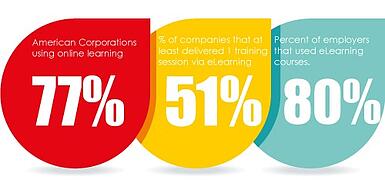
It's no secret that the training landscape has changed dramatically over the past ten years as eLearning and mobile technologies have gone from early-adopter novelties to mainstream essentials.
Still, there are plenty of traditional companies out there who aren't buying all of the eLearning hype or can't convince their boss or HR team to experiment in the brave new world of eLearning.
So we've rounded up more than a dozen powerful stats that are sure to be eye-openers, if not total mind-changers.
1. In 2011 77% of American Corporations were using online learning (in 1995 this number was only 4%). This means the number of companies using online training methods is dramatically increasing mainly because technological barriers are diminishing and customer priorities are shifting away from stand-alone training courses.
2. Corporate training alone is a $200 billion industry. eLearning represents $56.2 billion of this. This will grow into a $107 billion market by 2015. (GIA – Global Industry Analysts). This way, we can say corporate eLearning is one of the fastest growing, and, we believe most promising markets in the education industry.
3. The eLearning market is now more than 13 years old (the word “e-learning” was coined in 1998). Since then, eLearning has continued its rapid evolution and radically changing the training industry... View this infographic.
4. The US and Europe account for over 70% of the global eLearning industry. The fastest growing market, however, is Asia Pacific, with eLearning revenues expected to grow at an annual rate of 20%.
5. eLearning is the second most important training method within organizations, with companies increasingly moving towards blended learning and eLearning, rather than instructor led training sessions. The global market for eLearning is forecast to hit over $100 billion by 2015, with growth from the benefits of reducing operational costs, flexibility and simple training programs.
6. It's a fact than an increasing number of firms are relying on learning technology to help their business move forward. According to 2011 Towards Maturity Benchmark Survey, 72% of the 600 companies surveyed said that learning technologies such as eLearning and mobile learning helped their business adapt more quickly to change, an increase of 11% on last year.
7. According to New Ambient Insight Report, the Asian eLearning market is expected to reach $11.5 billion by 2016. It is revealed that the 2 countries with the highest growth rates in the world are Vietnam and Malaysia, with 44.3% and 39.4% respectively. Following closely behind these countries are Thailand, Philippines, India and China, with 30%-35% growth rate.
8. 4,600,00 college students are currently taking at least one of their classes online and by 2014 this number will increase to 18,650,000. By 2019, half of ALL classes will be done online. Watch this video.
9. eLearning is generally shorter than classroom training on the same subject by up to 25-60% (according to Brandon Hall, 2001 and Rosenberg 2001).
10. In 2011, 51% of companies delivered at least one training session via eLearning to over 50% of their employees, comprared to 39% in 2010. And for 76% of companies, the most popular delivery method of eLearning is blended learning. The 47% already using this approach are planning to intensify usage. (European Survey 2011)
11. According to the National Research Business Institute, 23 percent of employees leave for lack of development opportunities and training. The costs associated with losing talent, including money, lost productivity, recruitment expenses and training investments, have been well documented.
12. Main Business driver for eLearning: 85% of every dollar spent on classroom training is spent delivering it (instructor time, travel, etc).
13. eLearning is proven to increase knowledge retention by 25% to 60%. Corporate eLearning Exploring a New Frontier, WR Hambrecht.
14. “Less than 18% of corporate eLearning courses are on topics specifically related to an eLearner's job. Only 23% of corporate learning organizations target their programs to external customers. Only 13 % of corporate learning organizations target their programs to suppliers.” Corporate University Xchange's Pillars of e-Learning Success
15. Corporations save between 50% and 70% when they replace instructor-based training with eLearning (IOMA 2002). Training with eLearning means that courses can be delivered into shorter sessions and spread out over different days so that the business would not lose an employee for entire days at a time. Additionally, it improves productivity as employees no longer need to travel or fight rush-hour traffic to get to a class.
16. According to Towards Maturity Report 2011, eLearning courses were the most popular learning technology that year, used by 80% of employers.
17. Instructor Led training loses ground to eLearning moving from 70% of training delivered to 62%. Self-study e-learning (asynchronous) is on the rise now accounting for 15 % of all training delivered. This is a two-fold increase from just one year ago..." (2006 ASTD Industry Report)
18. Not surprisingly, the more advanced forms of eLearning are much more popular among larger firms and companies that are technology-savvy. At Fortune 500 firms, 73.6 percent of technology-delivered training comes through networked, online methods. (workforce.com)
Which of these eLearning statistics was the most surprising to you?









